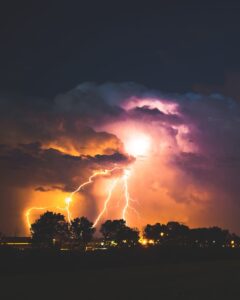Scripture: 2 Samuel 1-5 and I Chronicles 10-11
Learning Objectives:
- Students will learn God’s plans will happen in His timing, which may take longer than we would like.
- Students will learn bad things may happen while we are waiting for God’s timing, but that does not mean God is not with us or that He is not in control.
- Students will learn God does not want us to do sinful things in order to “speed up” His timing or in an effort to “help” God.
- Students will participate in an activity to help them remember God is with them in bad times and good times (the storms as well as in the rainbows).

Guiding Question:
- What can storms and rainbows teach us about how God works in our lives?
Materials:disposable pie “tins”, Styrofoam plates, new pencils, thumbtacks, clear plastic cup, water
Procedure: Tell students the story of David becoming King. Take the opportunity to briefly review everything that has happened since Samuel first anointed David as the future king. Explain to students that most people think it was at least fifteen years between the time David was anointed until he became King over part of Israel and another 7 ½ years until he was king over all of Israel.
Ask them if they could have been patient as long as David – especially if they had to go through everything David did. Help them begin to understand God has a plan for their lives, too. Probably not to be a king or queen (although who knows!), but they too may have to wait many years and go through some hard times until they understand what God wants for them.
Ask them what they remember about the story of Noah. Remind them it rained for 40 days and 40 nights, but it was about a year that he and his family were on the Ark. Ask them if they remember what God sent as a promise that he would never flood the entire earth again?
Explain that today; you will give them what they need to make lightening and a rainbow. Tell them that whenever they are worried or impatient waiting for God, they should remember King David and that even during the bad, stormy times while he waited – God was still there. Eventually, God kept His promise to David, just like He did to Noah and will to us.
Give each student a pie tin, pencil and a thumbtack (teachers should handle the thumbtacks for younger students and may want to make the “lightening rod” while allowing students to take the Styrofoam plate and create the static electricity). Have older students place the thumbtack up through the bottom of the center of the pie plate. They should stick the eraser end of a new pencil on the thumbtack. Have students rub the Styrofoam plate on their hair long enough to create static electricity, then place the Styrofoam plate on the table. They should then pick up the pie tin by the pencil and move it towards the Styrofoam plate. If the lights are off, you should be able to see sparks of “lightening”.
To make the rainbow, take students outside in the sun (hopefully!). Find a tabletop or other surface above the ground level. Fill the cups half full of water and place them half on the tabletop and half off the table (see the importance of being outdoors!). They should place the cup where the sun will shine through it. It may take a while to find the right spot, but when they do, a rainbow should appear on the ground below the cup.
Remind students when they are worried, scared or feel impatient with God, they can make lightening and rainbows at home and remember God is with them through the storms and the rainbows and He has a plan for their lives.
Additional Questions:
- What are some other examples in the Bible of God fulfilling His promises over time?
- What causes the “lightening”?
- What colors are in every rainbow and what is the order? How does this consistency remind us of God’s consistency?
Supplemental Activity: Have a word bank of important vocabulary. Define each. Have students repeat the experiment as though teaching it to someone new. Instruct students to include the vocabulary in their explanation. Vocabulary: static electricity, positive energy, negative energy, friction, rainbow order, prism, white light, etc. Praise them for being “scientists” and “teachers.” If the resources are available, students can even record themselves and make a how-to video.
